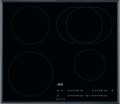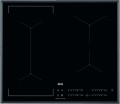Bridge mode
A function that allows you to combine two (or more) adjacent electric hotplates into one burner. Often, this mode is found in induction hobs, less often in Hi-Light, and is not used in gas hobs. Often the "bridge" looks like one continuous heater of an elongated shape, the individual parts of which can be turned on independently and are separate burners. Anyway,
the bridge mode (Bridge) can be useful primarily for working with elongated utensils — for example,
goose roasters. In addition, the design may provide various additional functions — for example, the ability to set different power settings for different parts of the "bridge" and move the dishes between them depending on the readiness of the dish. At the same time, unlike conventional burners, the heating will turn on automatically, according to the presence of dishes on the burner.
Oval dual zone
The presence of an
oval-shaped heating zone on the hob. Such a heater is useful for working with appropriate elongated dishes (for example, goose roasters). In models with electric heaters (see "Burner type") the desired shape is provided by an additional segment installed close to the burner; the burner in normal mode works like a regular round one, and when the segment is connected, it turns into an oval. In gas models, a separate elongated burner is installed.
A similar effect can be achieved using the bridge mode (see "Features"). However, the bridge and the oval zone are still different functions: the first involves combining two burners, and the second is implemented strictly on one burner.
Input power
The input power of the hob is the maximum electric power consumed during its operation. This parameter is indicated only for models that are equipped with at least one electric hotplate. It is electric burners that are the highest consumption in terms of energy consumption. Additional functions such as auto-ignition require little energy, and a regular outlet is enough for them.
First of all, the requirements for the power mains depend on this parameter: it must be able to provide such power without overloads. It is worth noting that for household sockets the power limit is about 3 – 3.5 kW, with more power, you need to connect the hob to 230 V mains according to special rules. An alternative is to use a three-phase 400 V mains: most modern hobs with electric burners allow connection to both 230 V and 400 V mains.

